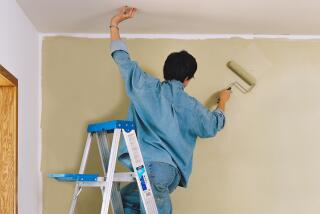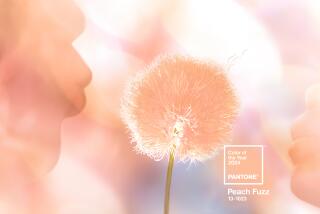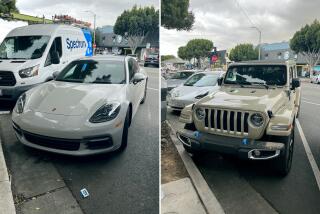For Better or Worse, It’s Shades of the Past : Design: Tickled by ivories? Does avocado suit your tastes? Then you’re in the pink because fashion forecasters say those old favorites rank among the next hot hues.
- Share via
Remember avocado green? If you were sentient in the ‘60s, you surely remember that particular shade. New suburban homes had shag carpet and appliances in avocado, wallpaper patterns were infused with it--even cars parked out front had avocado paint jobs.
The memory makes some people shudder.
“It’s best not to mention avocado,” says Jim King, an automotive color specialist for Troy, Mich.-based E.I. DuPont deNemours, who adds that the shade made green paint scarce in the automotive world for almost 30 years. “The saturation of avocado killed green.”
Avocado, along with harvest gold and brown, happened during the infancy of color forecasting, in which industry insiders and consultants identify and sometimes dictate the trends in color. The threesome left a lasting impression.
“It’s why you don’t see strong color trends (in appliances) now,” says Larry Yoder, an industrial designer for Iowa-based Amana. Given the longevity of refrigerators, for example, “too many people had to live with it or redecorate around it in later years.”
Although the guacamole green may never again reach appliance status, it is making its way back into the color fold for ’94. Olive is emerging in a new mix of earthy colors that also includes dusty purples, orange-reds, warm yellow-browns and beige-grays, forecasters say.
As the key players in the fashion, textile, home products and automotive industries, they agree on palettes so that the amethyst yarns for sweaters and the blue-violet paint for fenders will be ready when it’s purple’s time to shine. Without some agreement among manufacturers, finding compatible wallpaper, carpeting, tile and such would be difficult for consumers.
“Color doesn’t just happen in one industry,” says King, one of more than 1,000 representatives to attend a recent conference in San Diego sponsored by the nonprofit Color Marketing Group, which meets twice a year. “We put four to five hundred people in workshops where they bring ideas and try and promote a commonality. Forecasters work on the long range. Color trackers look at what is happening this year and next year.”
Each color has an emerging period, a peaking period, then a decline. “Colors evolve and the colors we are looking at are coming from colors that exist,” says Nada Napoletan Rutka, president of Color Marketing Group. “They don’t just come in and leave.”
The current appeal of teal--a happy marriage of green and blue that has been applied to everything from lunch boxes to Toyotas to sweaters--was predicted years ago, as neons began to fade. Teal, bright pink and happy-face yellow took the place of Day-Glo brights.
And black, which reigned during most of the ‘80s, started its takeoff in the ‘70s.
“We knew about the ‘Star Wars’ movie, about Darth Vader dressed all in black,” says Leatrice Eiseman, director of Eiseman Center for Color in Seabeck, Wash. “That black car in ‘Smokey and the Bandit’ got a lot of publicity. The Reagans were coming in, there was a feeling that, with a Republican sweep, a lot was going to happen--conspicuous consumption, a lifestyle of luxury, limos and formal wear.”
The last natural-color wave was in the early ‘70s, when macrame-brown and unbleached muslin played against tie-dyed rainbow hues. Later in the decade, colors that worked well under disco lights were popular: silver, metallic pastels and fabrics shot with gold.
Entertainment, politics, art, economics and geography all influence color trends.
“When areas in China and Russia were made more accessible, tourists came back with a sense of native dress and the colors they use,” Eiseman says. “When museum collections travel, they have an enormous effect on color. When Tut traveled, it began the metallic craze in fashion and spread into interior design.”
Colors are cyclic, and each industry has its own cycle. While appliance colors tend to last for about 10 years, the fashion industry chews up and spits out colors every six months. Fashion forecasters are pointing to earthy brown, green and off-white as hot fall shades that will remain popular through next spring.
“I call it ah-natural--it’s as big as black and white was three years ago,” says Barbara Fields, whose Los Angeles buying office services department and specialty stores nationwide.
In other industries, such perennials as red, blue and white never fall off the charts. The patriotic three are always the top color choices for cars; some years white is the best seller, other years blue is No. 1. Bright, fire engine-yellowish reds are always popular for sports cars, and burgundy or blue-reds are in great demand for luxury cars.
Despite the broad range of house-paint colors available for use inside and out, customers seem shackled to white. Glidden, for example, recently introduced an atlas into its stores featuring 6,134 sample colors. Off-white interior colors--antique white and Navajo white--dominate sales, says Ann Price, a color specialist for the Cleveland-based paint maker.
White is also the best-selling exterior color, she says, adding that people tend to save intense colors for exterior trim.
The predominant colors predicted for the ’95 palette are earthy greens, browns and ivories.
These choices are based not only on the ecology movement but also on economic considerations, Eiseman says. “When people are faced with buying a big-ticket item like carpet, they are retreating into neutrals as a way of saying, ‘I don’t want to take a chance.’ ”
More to Read
Inside the business of entertainment
The Wide Shot brings you news, analysis and insights on everything from streaming wars to production — and what it all means for the future.
You may occasionally receive promotional content from the Los Angeles Times.










